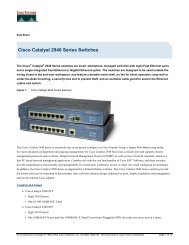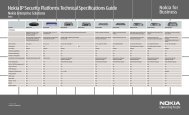Cisco Catalyst 2960 Series Switches - ESC Electronic Service Center
Cisco Catalyst 2960 Series Switches - ESC Electronic Service Center
Cisco Catalyst 2960 Series Switches - ESC Electronic Service Center
Create successful ePaper yourself
Turn your PDF publications into a flip-book with our unique Google optimized e-Paper software.
Availability and Scalability<br />
The <strong>Cisco</strong> <strong>Catalyst</strong> <strong>2960</strong> <strong>Series</strong> is equipped with a large set of features that allow for network<br />
Data Sheet<br />
scalability and higher availability through multicast filtering as well as a complete suite of Spanning<br />
Tree Protocol enhancements aimed to maximize availability in a Layer 2 network.<br />
Enhancements to the standard Spanning Tree Protocol, such as Per-VLAN Spanning Tree Plus<br />
(PVST+), UplinkFast, and PortFast, help to maximize network uptime. PVST+ allows for Layer 2<br />
load sharing on redundant links to efficiently use the extra capacity inherent in a redundant design.<br />
UplinkFast, PortFast, and BackboneFast all greatly reduce the standard 30- to 60-second<br />
Spanning Tree Protocol convergence time. Flexlink provides bidirectional, fast convergence in less<br />
than 100 milliseconds. The Loopguard and bridge protocol data unit (BPDU) guard enhancements<br />
provide Spanning Tree Protocol loop avoidance.<br />
Advanced QoS<br />
The <strong>Cisco</strong> <strong>Catalyst</strong> <strong>2960</strong> <strong>Series</strong> offers superior multilayer QoS features to help ensure that<br />
network traffic is classified and prioritized, and that congestion is avoided in the best possible<br />
manner. Configuration of QoS is greatly simplified through automatic QoS (Auto QoS), a feature<br />
that detects <strong>Cisco</strong> IP phones and automatically configures the switch for the appropriate<br />
classification and egress queuing. This optimizes traffic prioritization and network availability<br />
without the challenge of a complex configuration.<br />
The <strong>Cisco</strong> <strong>Catalyst</strong> <strong>2960</strong> <strong>Series</strong> can classify, reclassify, police, mark, queue, and schedule<br />
incoming packets and can queue and schedule packets at egress. Packet classification allows<br />
the network elements to discriminate between various traffic flows and enforce policies based on<br />
Layer 2 and Layer 3 QoS fields.<br />
To implement QoS, the <strong>Cisco</strong> <strong>Catalyst</strong> <strong>2960</strong> <strong>Series</strong> Switch first identifies traffic flows or packet<br />
groups, then classifies or reclassifies these groups using the differentiated services code point<br />
(DSCP) field or the 802.1p class of service (CoS) field. Classification and reclassification can be<br />
based on criteria as specific as the source or destination IP address, source or destination MAC<br />
address, or the Layer 4 TCP or UDP port. At the ingress, the <strong>Catalyst</strong> <strong>2960</strong> <strong>Series</strong> also polices to<br />
determine whether a packet is in or out of profile, marks to change the classification label, passes<br />
through or drops out of profile packets, and queues packets based on classification. Control-plane<br />
and data-plane ACLs are supported on all ports to help ensure proper treatment on a per-packet<br />
basis.<br />
The <strong>Cisco</strong> <strong>Catalyst</strong> <strong>2960</strong> <strong>Series</strong> supports four egress queues per port, giving network<br />
administrators more control in assigning priorities for the various applications on the LAN. At<br />
egress, the switch performs congestion control and scheduling, the algorithm or process that<br />
determines the order in which queues are processed. The <strong>Catalyst</strong> <strong>2960</strong> <strong>Series</strong> Switch supports<br />
Shaped Round Robin (SRR) and strict priority queuing. The SRR algorithm helps ensure<br />
differential prioritization.<br />
These QoS features allow network administrators to prioritize mission-critical and bandwidth-<br />
intensive traffic, such as enterprise resource planning (ERP), voice (IP telephony traffic), and<br />
computer-aided design and manufacturing (CAD/CAM), over applications such as FTP or e-mail.<br />
For example, it would be undesirable to have a large file download destined to one port on a<br />
switch increase latency in voice traffic destined to another port on this switch. This condition is<br />
avoided by ensuring that voice traffic is properly classified and prioritized throughout the network.<br />
Other applications, such as Web browsing, can be handled on a lower-priority basis.<br />
All contents are Copyright © 1992–2007 <strong>Cisco</strong> Systems, Inc. All rights reserved. This document is <strong>Cisco</strong> Public Information. Page 4 of 14







